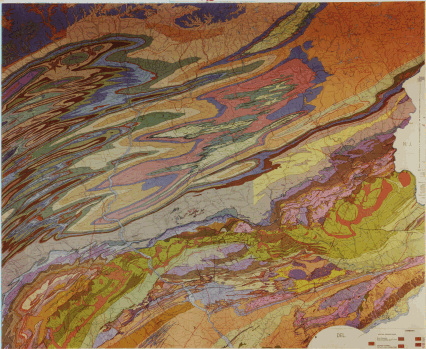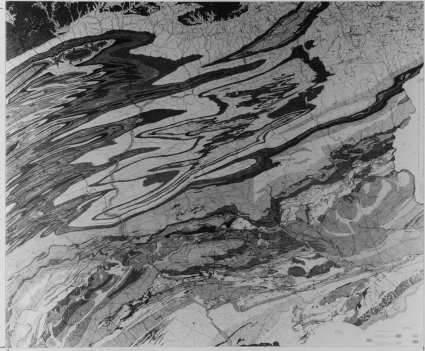



Colors in color film are produced by coupling (stacking) multiple layers of emulsions containing light-sensitive compounds [organic dyes] that filter out different wave lengths. In subtractive color film, these dyes are specified by these colors: cyan, magenta, and yellow. Using the primary colors as reference, yellow subtracts blue, magenta, green, and cyan subtracts red. As irradiated by multi-colored light, light from areas in the target or source corresponding spatially to objects reflecting as blue will on passing through the color film bleach out parts of the yellow emulsion; the same pattern holds for green and red light, affecting the magenta and cyan layers respectively. When white light is passed through the multilayers of the resulting transparencies [e.g., 35 mm slides], the now clear yellow areas will be rendered blue because the remaining cyan and magenta [so colored over these same areas] will filter out [subtract] red and green leaving blue to display in the areas. The same reasoning holds for the other two primaries. In color negative film from which color prints are made, the layer sensitive to red produces its complement color in the negative, which when printed onto paper produces red by leaving behind magenta and yellow dyes [subtractive color system]. We will not elaborate further on the printing rationale; suffice to say that red in print represents red from the source, green - green, and blue - blue after all steps are executed. Much more about film/camera processes is reviewed in Section 10-2.
To illustrate the concepts introduced in the first paragraph, we will reproduce here the same four panels used to exemplify multispectral imagery as shown on page 34 of the Landsat Tutorial Workbook. The upper left panel shows the southeastern section of the colored geologic map of Pennsylvania.
 |
 |
| Color Photo | Blue Filter |
 |
 |
| Green Filter | Red Filter |
This map, illuminated in bright sunlight, was photographed thrice on standard black and white film through three narrow bandpass filters, centered on segments of the visible spectrum in the blue, green, and red respectively. Look first at the resulting black and white photo made with a blue filter. Light reflected from the bluer patterns in the map will pass through the blue filter with high transmission (low to moderate absorption); the film negative receiving such light is strongly exposed (high silver density) and a positive print made therefrom will show the blue areas as light shades of gray. Conversely, the red and orange reflected from the map is highly absorbed by the blue filter, causing only slight densities in the negative and very dark shades in the print. Greens in the map show as intermediate gray shades in this blue band print. The same reasoning can be applied to the green and red band prints. Thus, red patterns will display as light-toned in the red band print and moderate gray levels in the green band print. Note that some colors tend to produce generally darker shades in all three filter prints, as for example the dark reddish-brown zig-zag pattern in the left side of the map. This results in part from the inherent darkness (low level of saturation) of this particular color and also from the nature of brown itself ( a mix of red and yellow with black).
Color-filtered b & w pictures can be used with color filters to produce color composites by projected superposition. To do this, imagine this experimental setup. Any scene containing many features and classes of differing colors will suffice. First, replace the prints with positive transparencies (tonally analogous to prints). Work with three b & w transparencies, made with blue, green, and red filters respectively. Shine white light through each one mounted in its own lamp projector (total of three) on to a screen. Project the blue transparency through a blue filter, the green through green, and red through red. Co-register the three projections by superimposing several distinctive patterns noted in common within the photographed scene. Blue features = clear areas on its (blue) transparency is projected through the blue filter as blue, green on its as green, red as red.The result will be a simulated natural color "image". Other colors present are additive mixes of two or more primaries (e.g., yellow is a mix of red and green; orange is a mix of more red and some green; white is an equal mix of all three primaries, and black is simply the absence of any colored light of any wavelength).
If, instead, one of the transparencies consists of b & w infra-red film (ordinarily used to emphasize a property of healthy vegetation in which light in the range of 0.7 - 1.1 µm is strongly reflected from the internal cells of plants, giving rise to bright tones in the film), a false color composite can be generated by projecting a green = light tones transparency through a blue filter, a red through green, and this IR-transparency (with light tones corresponding to vegetation) through a red filter. The outcome is a
exemplified here as an aerial view of shrub-land and a field. This is a notably different color version in which various kinds of vegetation are displayed in several tones of red, pink, or yellow (the latter two may indicate degree of stressed or unhealthy vegetation). When this film combination is used in military reconnaissance photography, weapons camouflage simulating vegetation is not red but another hue, usually dark green, because the high near-IR reflectance from healthy vegetation is absent. Or, in a more familiar mode, color IR photos (and sensor-derived images that include an IR band) would show a football field with natural grass in bright red as compared with artificial turf (Astroturf) in a dark, non-red tone.
Code 935, Goddard Space Flight Center, NASA
Written by: Nicholas M. Short, Sr. email: nmshort@epix.net
and
Jon Robinson email: Jon.W.Robinson.1@gsfc.nasa.gov
Webmaster: Bill Dickinson Jr. email: rstwebmaster@gsti.com
Web Production: Christiane Robinson, Terri Ho and Nannette Fekete
Updated: 1999.03.15.